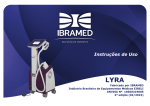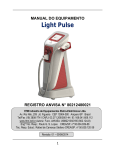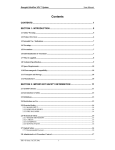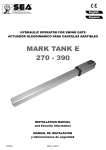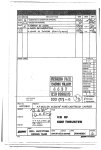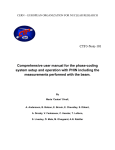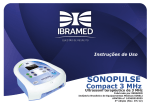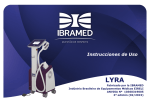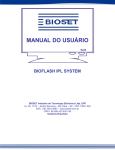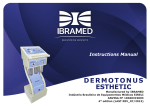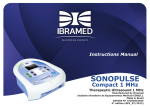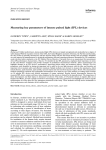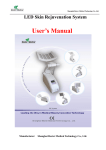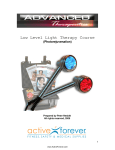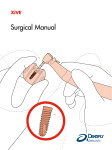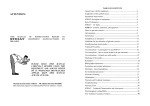Download Instructions Manual
Transcript
Instructions Manual LYRA Manufactured by Ibramed Indústria Brasileira de Equipamentos Médicos EIRELI Made in Brazil ANVISA nº10360319005 2ª edition (02/2015) TABLE OF CONTENTS SYMBOL DEFINITIONS..................................................3 ON THE EQUIPMENT.............................................4 CARTON.............................................................5 LIST OF ABBREVIATIONS..............................................6 LIST OF FIGURES.........................................................6 LIST OF TABLE..............................................................8 PREFACE...............................................................9 PRODUCT DESCRIPTION...............................................9 ESSENTIAL PERFORMANCE....................................9 SAFETY PRECAUTIONS................................................10 INFORMATION ON INTENSE PULSED LIGHT....................12 RESPONSIBILITY FOR USE ELECTROMEDICAL EQUIPMENT.....15 INDICATIONS, CONTRAINDICATIONS AND PRECAUTIONS....16 PRECAUTIONS AND ADVERSE REACTIONS....................17 PATIENT PROFILE, USER PROFILE AND CONDITIONS OF USE...18 GENERAL CARE WITH THE EQUIPMENT..........................19 TRANSPORT DAMAGE..........................................19 CARES WITH THE EQUIPMENT..............................19 INSTALLATION, CARE AND CLEANING...........................20 INSTALLATION INSTRUCTIONS.............................20 CLEANING LYRA.................................................20 CLEANING THE HANDPIECE AND FILTERS..............20 GOGGLES CARE AND CLEANSING.........................20 NOMENCLATURE.........................................................21 SPECIFICATIONS........................................................24 ACCESSORIES USED...................................................25 OPERATING INSTRUCTIONS.........................................27 2 PREPARING THE EQUIPMENT................................27 USING THE EQUIPMENT.......................................31 USING THE MENU KEY.........................................33 PROGRAMMING THE EQUIPMENT..........................41 EMERGENCY STOP BUTTON..................................49 PROTECTION WARNINGS OF THE EQUIPMENT.........50 PREPARATION FOR IPL THERAPY...................................55 CARES PRIOR TO TREATMENT..............................55 BEFORE STARTING THE TREATMENT......................55 SKIN PHOTOTYPE...............................................56 PRE-TEST..........................................................56 SUGGESTION OF INTERVAL AND NUMBER OF SESSIONS....56 PRE-PROGRAMMED DOSES..........................................57 APPLICATION TECHNIQUE............................................61 SIMPLIFIED SEQUENCE.......................................61 REFERENCES.............................................................62 ELECTROMAGNETIC COMPATIBILITY GUIDANCE..............63 POTENTIAL ELECTROMGNETIC INTERFERENCE..........63 ELECTROMAGNETIC COMPATIBILITY..............................64 ENVIRONMENTAL INFLUENCES.....................................70 ACCESSORIES WHICH ACCOMPANY LYRA.......................71 REPLACEMENT ACCESSORIES..............................72 TROUBLESHOOTING...................................................72 REPLACING THE PROTECTION FUSE......................73 MAINTENANCE, WARRANTY AND TECHNICAL SUPPORT....74 CEFAI – IBRAMED Center for Education and Advanced Training...........................................................77 SYMBOL DEFINITIONS BELOW ARE THE DEFINITIONS OF THE SYMBOLS USED ON THE EQUIPMENT AND THROUGHOUT THE INSTRUCTIONS FOUND IN THIS MANUAL. UNDERSTAND THESE SYMBOLS AND THEIR DEFINITIONS BEFORE OPERATING THIS EQUIPMENT. Symbol danger, caution, radiation Caution! Refer to user manual. Equipment with applied part of BF type. It indicates: Off (no electric voltage) It indicates: On (with electric voltage). Dangerous Voltage. Alternating Current. CLASS I CLASS 1 equipment. It has grounding resources for protection. Electric network in Alternating Current. Equipment not protected against harmful water penetration. Sensitivity to electrostatic discharge. 3 SYMBOL DEFINITIONS ON THE EQUIPMENT Do not step on the equipment surface. Do not sit on the equipment. Non-ionizing radiation. Refer to the instructions manual/brochure. Note: follow the instructions of use. 4 SYMBOL DEFINITIONS CARTON FRAGILE: The content in this package is fragile and must be transported carefully. Brazilian certification seal. This side up. serial number. Limits of temperature for storage and packaging in °C (Degrees Celsius). Keep away from the rain. Do not stack up. Do not use if the packaging is damaged. Check the operating instructions. Indication address. of the maufacturer’s name and 5 LIST OF FIGURES LIST OF ABBREVIATIONS LIP Intense Pulsed Light TRT Thermal relaxation time (TRT) J Joule J/cm² Joule per square centimeter J/s Joule per second W Watt E Energy F Fluency nm Nanometer ms Millisecond cm² Square centimeter Figure 1. Absorption spectrum of main skin chrom ophores......................................................14 Figure 2. A, frontal view and B, rear view of LYRA.........21 Figure 3. A, handpiece of LYRA; B, frontal view of handpiece and C, rear view of handpiece........................................22 Figure 4. Handpiece of LYRA..................................25 Figure 5. A, electrical feed cable and B, footswitch p edal..............................................................25 Figure 6. Hose with funnel and drainage hose for filling up the water reservoir. The drainage hose can also be used to empty the water reservoir..........................................25 Figure 7. Filter according to the type of treatment: Available options 480 nm, 530 nm and 660 nm.....................26 Figure 8. A, colorless gel, B, cuvette and C, spatula........26 Figure 9. A, protective goggles for therapist and B, protective goggles for patient.......................................26 Figure 10. Warning of low level of water of supply mode..........................................................28 Figure 11. Instruction screen about the supply mode of the water reservoir....................................................28 Figure 12. Removal of connection plug......................29 Figure 13. Connection of hose..................................29 Figure 14. Removal of connection hose......................29 Figure 15. Supply and periodical substitution of demineralized water of the tip cooling water.....................30 Figure 16. Drainage of water reservoir....................30 6 LIST OF FIGURES Figure 17. Figures A and B show the introductory message of LYRA.......................................................31 Figure 18. Screen for insertion of safety password.......32 Figure 19. Treatment selection screen.........................32 Figure 20. Interactive menu.......................................33 Figure 21. INFO Summary...........................................33 Figure 22. Indications of use of equipment..................33 Figure 23. A and B, contraindications of use of equipment..34 Figure 24. Possible adverse reaction which may occur in case of excessive dose................................................34 Figure 25. Step 1 of 6 of programming the equipment..35 Figure 26. Step 2 of 6 of programming the equipment.... 35 Figure 27. Step 3 of 6 of programming the equipment.....35 Figure 28. Step 4 of 6 of programming the equipment....35 Figure 29. Step 5 of 6 of programming the equipment...36 Figure 30. Step 6 of 6 of programming the equipment...36 Figure 31. Step 1 of 3 of preparing the handpiece..........36 Figure 32. Step 2 of 3 of preparing the handpiece..........36 Figure 33. Step 3 of 3 of preparing the handpiece........... 37 Figure 34. Step 1 of 3 of preparing the patient...........37 Figure 35. Step 2 of 3 preparing the patient...........37 Figure 36. Step 3 of 3 preparing the patient...........37 Figure 37. Step 1 of 5 of application technique...........38 Figure 38. Step 2 of 5 of application technique...........38 Figure 39. Step 3 of 5 of application technique.......38 Figure 40. Step 4 of 5 of application technique........38 Figure 41. Step 5 of 5 of application technique.......39 Figure 42. General Directions for the use of the equipment..39 Figure 43. Safety password alteration screen........39 Figure 44. Language selection screen........................40 Figure 45. A, parameter selection key and B, warning of verification of 640 nm filter.......................................41 Figure 46. A, system loading of LYRA and B, screen with selected parameters of Example 1and the energy which will be used in the treatment............................................42 Figure 47. A, screen for selecting the parameters and B, filter check warning 530 nm.......................................43 Figure 48. A, system loading of LYRA and B, screen with the selected parameter of Example 2 and the energy which will be used in the treatment...................................................44 Figure 49. A, screen for selecting parameters and B, filter check warning 480 nm.....................................45 Figure 50. A, system loading of LYRA and B, screen with the selected parameter of Example 3 and the energy which will be used in the treatm ent............................................................46 Figure 51. A, screen for selecting parameters and B, filter check warning 480 nm.....................................47 Figure 52. A, system loading of LYRA and B, screen with the selected parameter of Example 4 and the energy which will be used in the treatment...................................................48 Figure 53. A, emergency button and B, emergency s 7 LIST OF TABLES LIST OF FIGURES Table 1. Detailing of pre-programmed doses for hair r e m o v a l ...........................................................58 Table 2. Detailing of doses for telangiectasia treatment. Observe the duration of the interval between the pulses highlighted in parenthesis................................................ 59 Table 3. Pre-programmed doses for Skin Tigtening. Observe the duration of the interval between pulses highlighted in parenthesis............................................................59 Table 4. Pre-programmed doses for Spots Skin. Observe the duration of the interval between pulses highlighted in parenthesis............................................................60 creen................................................................49 Figure 54. Warning that the water reservoir is below lev el.....................................................................50 Figure 55. Instructions on the filling up procedure of water reservoir..........................................................50 Figure 56. Warning of problems in the water cooling of handpiece tip.............................................................51 Figure 57. Instructions on the problems in the water cooling system of handpiece tip.............................................51 Figure 58. Warning of equipment without handpiece.......52 Figure 59. Instructions on the connection procedure of the handpiece. .........................................................52 Figure 60. Warning of problems in the cooling system pump of the handpiece................................................53 Figure 61. Instructions on the procedure for problems in the pump of the handpiece tip cooling system....53 Figure 62. Warning of problems in the system (ha rdware)........................................................54 Figure 63. Instructions on problems in the system (hard ware).................................................................54 Figure 64. Adapted Fitzpatrick scale...........................56 Figure 65. Opening the LYRA fuse box........................73 Figure 66. Removal of the fuse box drawer....................73 Figure 67. Repositioning of the fuse box drawer..............73 8 PRODUCT DESCRIPTION PREFACE ESSENTIAL PERFORMANCE These instructions of use allow the user the efficient use of LYRA. Consult appropriate literature to obtain additional information about the uses of the oscillating vibration impact technique. Before stating any treatment on a patient, the user must read, understand and follow the information in these instructions of use for each mode of treatment available, as well as the indications, contraindications, warnings and precautions. The specifications and instructions contained in these instructions of use are in effect on the date of their publication. These instructions may be updated at any given moment, at the manufacturer’s discretion. Visit our website for updates. LYRA is Intense Pulsed Light (IPL) micro controlled equipment designed for use in aesthetics, dermato-functional, aesthetic biomedicine and other fields of aesthetics. LYRA has a handpiece with the possibility of interchange of three selective cut filters with wavelengths of 480 nm, 530 nm and 640 nm which allow the professional to choose the most adequate spectrum of light radiation for each treatment. LYRA has a peltier and water cooling system which cools the tip of the handpiece (crioprotection) making the treatment safer and more comfortable. The fractioning of pulse produced by LYRA minimizes even more the risk of lesions. O LYRA has a lamp with useful life of 1.000.000 shots which allows for linear and functional performance. 9 SAFETY PRECAUTIONS DEFINITIONS OF PRECAUTIONS the precautions instructions found in this section and throughout these instructions of use are indicated by specific symbols. It is necessary that you understand these symbols and their definitions before starting to operate this equipment and before the therapy session. • Read, understand and practise the precaution and operation instructions. Know the limitations and dangers associated with the use of any electro stimulation. Observe the precaution and operation labels placed on the unit. • Do not operate this unit in an environment where other devices intentionally propagate electromagnetic energy in an unprotected manner. • This unit must be transported and stored at temperatures between 5° C and 50° C (41° F and 122° F). Avoid humid and dusty environments. The equipment must not be stacked and/or placed next to other equipment. • Check the cables and connectors before each use. • Do not use sharp objects, such as a pencil or pen to operate the buttons on the operator interface, as it can damage it. • Hold the applicator carefully. Improper use of the applicator may adversely affect its characteristics. • LYRA was not designed to avoid water penetration or infiltration of any other liquids. The infiltration of water or other liquids may cause malfunction of the internal components of the system and consequently, pose risk to the patient. • Disconnect the plug from the outlet when the device is not in use for long periods of time. Text with indication “Attention” refers to potential safety infractions in potential which may cause minor to moderate lesions or damage to the equipment. Text with indication “Warning” refers to potential safety infraction in potential which may cause serious injury and damage to the equipment. Text with indication “Danger” refers to potential safety infractions which represent immediate threat to life and result in death or serious injury. 10 SAFETY PRECAUTIONS • To protect against the risk of fire, use only replacement fuses of the same type and classification. • Certify that the unit is grounded, connecting it to an outlet grounded according to the national and local applicable codes. • Before treating the patient, it is necessary to know the operational procedures for each mode of treatment available, as well as the indications, contraindications, warnings and precautions. Refer to other resources to obtain additional information about the applications the LYRA. • To avoid electric shock, turn the equipment off from the electrical feed before performing any maintenance • Patients with neurostimulation devices or implanted pacemakers must not be treated or must be distant from any short wave diathermy, microwave diathermy, ultrasound diathermy or Intense Pulsed Light diathermy on any part of their bodies. The diathermy energy (shortwave, microwave, ultrasound and IPL) may be transferred though the implanted neurostimulation system, and it may cause damage to the tissues, resulting in serious injuries or even death. Damage, wounds and death may occur during Therapy with diathermy even if the implanted system is turned off. • Equipment that is not adequate for use in the presence of an ANESTHETIC MIXTURE FLAMMABLE WHEN IN CONTACT procedure. WITH AIR, OXYGEN OR NITROUS OXIDE. Equipment is not AP or APG category. 11 INFORMATION ON INTENSE PULSED LIGHT INTENSE PULSED LIGHT (IPL) The use of polychromatic light was first described in 1976 by Muhlbauer et al. for the treatment of vascular malformations. The photothermolysis of pigmented structures, cells and organelles by selective absorption of pulsed radiation has been described in detail since 1983. In 1990, Goldman and Eckhouse described a new high intensity flash lamp as an adequate tool to treat vascular lesions. Intense Pulsed Light (IPL) was commercially launched as a medical device in 1994. In the following years, several technical modifications allowed easy handling, the increase in safety and the widened spectrum of potential indications. of secondary effects; in the second generation of IPL devices, however, cut filters were incorporated in the infrared portion and also cooling techniques, significantly reducing the sideeffects. Energy Energy is a concept which allows quantifying the interactions between quite different phenomena; its official unit is the Joule. Power, on the other hand, is measured in Watts (1 W = 1 J/s) and the energy represents the quantity of light which comes out of the optical conductor, divided by the duration of this energy. Flash lamp and filters LIP devices use flash lamps and microcontrolled capacitor banks to generate high intensity polychromatic pulsed light. The electric energy stored in the capacitor banks passes through the xenon gas contained in the lamp so that the bright light is emitted; therefore, the electric light is converted into optical energy. Using filters, it is possible to select wavelengths according to the depth of the structure intended to be reached. The IPL emission spectrum varies from 450 to 1200 nm and, for example, when a 640 nm filter is used, the emission occurs only in the 640 to1200 nm spectrum, blocking the emission of shorter wavelengths. The first generation of IPL devices emitted part of the infrared spectrum, which led to predominantly epithelial damage, and an elevated incidence Fluency It is the quantity of energy applied in the tissue in relation to the area over which the energy is applied. The measurement unit is J/cm2 (Joule per square centimeter). Duration of flash The duration of pulse is the time it takes to emit energy. For a better understanding of the relation between the duration of exposure of the structure to light and the confinement of heat, a very useful theoretical concept is used, called Thermal Relaxation Time (TRT). The TRT of a structure is defined as the time required for the heat generated by the absorbed light within the target chromophore to cool to half of the 12 INFORMATION ON INTENSE PULSED LIGHT original value immediately after the emission of the light pulse. The pulse duration must be smaller than the TRT of the target tissue, for in lengthy exposures, a uniform heating of the adjacent tissues consequent lesion occur. Some ILP devices emit light in fractioned pulses, in subpulses. This is the concept which most contributed to the success of the IPL technique. The fractioning of pulses in double or triple pulses allows the epidermis and thin vessels to cool in the intervals between the pulses while the thicker vessels and hairs remain heated. conducts light. • And also electrical components, such as control buttons for the flashes, among others. Interaction with the tissue Similarly to laser, in IPL devices the basic principle is the absorption of photons by endogenous or exogenous chromophores inside the skin and the transfer of energy to these chromophores. This transference generates heat, which subsequently destroys the target structure. The absorption of light is not linked to the coherence of light; the so called photobiological reaction occurs independently of the heating source. Besides, the chromophores in the human skin (hemoglobin, melanin, water) show wide spectra of absorption, therefore the monochromaticity is not a requisite for photothermolysis. As the IPL emit a spectrum of wavelength, the three chromophores can be activated with a single exposure to light. This versatility implies a reduced selectivity, the skin type and the skin condition of the patient determines the choice of suitable cut-off filters, and therefore, the spectrum of the wavelengths to be emitted. Handpiece (Applicator) The handpiece or applicator is essentially composed of: • A flash tube which transforms the electric energy which comes into its terminals into intensely bright white light. This tube is made of quartz, to support the strong thermal and mechanical limitations. Normally, it is filled up with xenon, a rare type of gas which allows good performance. • A reflector whose objective is to resend the maximum amount of light to the optical tube. These reflectors may be of either golden metal or reflexive white material. • An optical filter for each application, the absorption filters being the ones with the best performance. • An optical conductor very transparent whose role is to transfer filtered luminous beams to the skin to be treated. The principle is the same of that of an optical fiber which 13 INFORMATION ON INTENSE PULSED LIGHT Interaction with the tissue Figure 1. Absorption spectrum of main skin chromophores. Pulse duration can be adjusted at relatively wide intervals (depending on the device) in the millisecond range. The combination of particular wavelengths, pulse durations, pulse intervals, and fluences facilitates the treatment of a wide spectrum of skin conditions, such as acne vulgaris, pigmented lesions, vascular lesions, unwanted hair growth, photodamaged skin, scars and angiokeratoma 14 RESPONSIBILITY FOR USE ELECTROMEDICAL EQUIPMENT The use of electromedical equipment is restricted to a physician or under his command, the physical therapists or health professionals properly licensed. The professional will be responsible for properly licensed use and operation of the equipment. IBRAMED makes no representations regarding laws and federal, state or local laws that may apply to the use and operation of any electromedical equipment. The physician or under his command, also the physical therapist or other professional health care licensed assumes total and full commitment to contact the local certifying agencies to determine any credential required by law for clinical use and operation of this equipment. The use of electromedical equipment must comply with the local, state and federal country. 15 INDICATIONS, CONTRAINDICATIONS AND PRECAUTIONS INDICATIONS autoimmune conditions). • Patients with healing deficit due to Diabetes Mellitus or other pathologies. IPL is commonly indicated in the treatment of the following conditions: • Hair removal. • Permanent reduction of hairs. • Treatment of acneic skin. • Treatment of lesions (telangiectasia). • Treatment of rosacea. • Treatment of benign pigmentary lesions. • Cutaneous photoaging (rejuvenation). PRECAUTIONS CONTRAINDICATIONS • If the patient is undergoing natural or artificial tanning processes up to 4 weeks prior to the treatment. • Pregnant women. • In areas with suspected spots or which have potentially cancerous tissue. • Treatment area with tattoos or permanent make-up. • Pointing directly at people’s or animal’s ayes. • Presence of implanted electronic device (e.g. cardiac pacemaker). • Patients with photosensitive epilepsy. • Concomitant use of photosensitizing medicine. • Patients presenting particular sensitivity to solar irradiation or conditions related with photosensitivity (e.g. porphyria, polymorphic light eruption, solar urticaria, lupus and other 16 • Avoid solar exposure of the treated areas for at least 5 days after the application; the use sunscreen FP60 is strongly recommended. • A medical evaluation previous to the IPL treatment is strongly recommended in those cases in which the patient presents any skin pathology. • Do not perform ILP treatment when the patient is being treated with antibiotics, ingesting vitamin A supplements and/or other melanin stimulating substances. • In the hair removal treatments, the use of other depilatory practices must be avoided in the two weeks prior and subsequent to the application of IPL. Only shave the hair. • Skin of high phototype (dark or deeply tanned) requires closer attention as to the prescription of dosage for IPL application. • Soon after the application, slight erythema and/or transitory edema may occur; they will disappear in up to 3 hours after the application. The use of soothing lotions and/or cold patches over the treated areas may minimize such effects. • Rarely may appear more intense erythema which will disappear between 2 and 7 days after the application without PRECAUTIONS AND ADVERSE REACTIONS PRECAUTIONS PREVENTION OF ADVERSE REACTIONS the need for additional treatment. However, if desired, the use of soothing products, such as gel, creams or specific ointments may hasten the recovery process. • All the treated areas must be cleaned with water and neutral soap. • Make sure the conditions of the area to be treated and the real phototype are evaluated at each session. • Make sure the area to be treated is inspected before and after the treatment and interrupted if there is adverse reaction. Some patients are more sensitive to IPL and may experience a reaction similar to a skin eruption (e.g. patients who are under medication which increase sensitivity to light). POSSIBLE ADVERSE REACTIONS There are no significant records of more serious adverse reactions (transitory or permanent) stemming from the use of IPL Therapy provided that the applications are adequate to the patient. However, the following may occur: • Transitory hyperpigmentation (resolved without adjuvant treatments in up to 6 months after the application. • Dyschromia. • Itching. • Burns. • Erythema or local edema (from 30 minutes to 72 hours). • Purpura. BIOCOMPATIBILITY – of the materials in contact with the patient (ISO10993-1): Ibramed declares that the contact surface of the handpiece supplied with the equipment does not cause allergic reactions. This applicator must be positioned only with the intact surface of the skin, respecting a time limit of duration of 24 hours maximum. 17 PATIENT PROFILE, USER PROFILE AND CONDITIONS OF USE PATIENT PROFILE instructions of use for each mode of treatment available, as well as the indications, contraindications, warnings, possible adverse reaction and precautions. • The user must have his cognitive functions intact. • The user must have the necessary motor skills to handle the equipment. • Regarding mobility, this equipment is considered Portable equipment. • Patients with facial and/or body aesthetic conditions that are in accordance with the indications of use of the device. • Patients must be at least 12 years of age, under this age the use of the device must occur only under medical prescription. • Patients must weigh more than 35 kg, under this weight the use of the device must occur only under medical prescription. • Patients must have their level of consciousness preserved. PART OF THE BODY ON WHICH IT IS APPLIED OR WITH WHICH IT INTERACTS USER PROFILE • The equipment must be used only under prescription and supervision of a licensed health professional. Areas of the trunk, face, neck upper and lower limbs. Polychromatic light interacts with the skin of the treated area. • The equipment does not require specialized training; however the user of the device must read, understand and practise the instructions of precaution and operation. • The user must know the aspects relative to IPL Therapy and their interaction with the soft tissues. • The user must know the limitations, and dangers associated with the use of any IPL device and observe the precaution and operation labels placed on the unit. • The user must follow the information contained in these 18 GENERAL CARE WITH THE EQUIPMENT CARES WITH THE EQUIPMENT TRANSPORT DAMAGE LYRA is shipped complete to the cliente inside a box. Upon receiving it, inspect the box and the equipment to visualize any possible damage. In case of damage, keep all the transport materials, including the packaging, and contact the agents in charge for the delivery of the unit. All complaints regarding damage during transport must be presented directly to them. The manufacturer will not be responsible for any damage during transport, will not perform adjustments unless a formal complaint is presented by the receiver against the transport agent. The box in which your LYRA was delivered was especially designed to protect the equipment during transport. Keep the transport packaging in case you need to return your equipment for maintenance. Keep the transport packaging in case you need to return your equipment for maintenance. • Avoid places subject to vibration. • Do not place it on top of rugs, cushions or other smooth surfaces which obstruct ventilation. • Avoid damp, warm and dusty places. • This equipment is not protected against harmful water penetration. • Make sure that the area around the electrical feed cable is free. • Do not insert objects in the orifices of the device. • Temperature range during transport and storage: 5 - 50° C/ 41 - 122° F. 19 INSTALLATION, CARE AND CLEANING INSTALLATION INSTRUCTIONS applicator and expose the patient to the risk of burns due to the evaporation of the filter film, due to the high temperature it can reach in the places where residues accumulate. 1. Connect the energy cable to the rear part of LYRA. 2. Connect the energy cable to an outlet (127-240 V~ 50/60 Hz). 3. Connect the handpiece to the equipment. 4. Turn on your equipment. GOGGLES CARE AND CLEANSING CLEANING LYRA Carry out a visual inspection of your goggles, checking if the lens is not damaged. If it is dirty, wash it carefully with water and soap so that it does not get scratched. Also check the frames. It must be ventilated and fit comfortably to the face. If necessary, take it to an optician to be adjusted. At the end of the treatment, put it away inside the transport case. Do not place any weight over the goggles. The equipment must be cleaned daily, or in case there is need, immediately after its use. Do not immerse the equipment in liquids. Do not use volatile substances (benzene, alcohol, thinner or solvents in general) to clean the cabinet, because they may damage the finishing. Turn the equipment off of the electrical feed source, clean it using a cloth humidified with water and soft antibacterial soap. The cleaning procedure should be performed whenever necessary. Ibramed suggests weekly cleaning of the equipment. CLEANING THE HANDPIECE AND FILTERS Humidity, grease and dust are the main factors of filter damage. Constantly cleaning these items increases their useful life significantly. After each use and its complete cooling, the handpiece optical filters must be cleaned using gauze or paper towel damped in alcoholic chlorhexidine. Cotton residues and paper fibers must be removed using a paintbrush. Cleaning the filter is necessary since the residues accumulated in it or in the metallic part may damage the The correct installation, operation and maintenance of the equipment prevent safety risks. WARNING: To avoid risk of electrical shock, this equipment must be connected only to a mains power line with protective grounding. 20 NOMENCLATURE SYSTEM CONTROLS AND CONNECTIONS A 5 B 3 1 – On/off key. 2 – Output connection of handpiece. 1 3 – Handpiece rack. 11 4 - Ouput connection of the footswitch. 5 - Touchscreen 7 2 6 – Quick connection for the hose and funnel of 6 the water reservoir (Water Supply). 7 – Quick connection for the hose (Water Vent). 8 – Quick connection for the hose (Water Drain). 9 - Electrical feed connector. 10 – Protection fuse box. 11 – Emergency stop button. 4 9 8 10 Figura 2. A, frontal view and B, rear view of LYRA. 21 NOMENCLATURE HANDPIECE CONTROL AND CONNECTIONS A C 17 18 12 B 15 Figure 3. A, handpiece of LYRA; B, frontal view of handpiece and C, rear view of handpiece. 12 - Handpiece connector. 13 13 - Lamp shot counter. 14 - Cooling tip. 15 - Upper switch for flash emission control. 16 - Lower switch for flash emission control. 16 17 – Aperture for insertion of filter. 14 18 – Handpiece cord. 22 NOMENCLATURE READ AND UNDERSTAND THESE SYMBOLS AND THEIR DEFINITION BEFORE OPERATING THE EQUIPMENT HOME key: allows access to treatment selection. ATTENTION: Alert warning! Key which gives access to INFO, SAFETY PASSWORD and LANGUAGE. Key which allows returning to the previous screen. PASSWORD ALTERATION key: allows altering the safety password. Key which allows advancing to the next screen. Tecla ALTERAÇÃO DE SENHA: permite alterar a senha de segurança. Key for confirmation. LANGUAGE key: allows altering the language: Portuguese, Spanish or English. Key indicating condition. IPL is on STAND BY Key indicating IPL is on AVAILABLE condition. For emission, just press the trigger on the handpiece. 23 SPECIFICATIONS SYSTEM HANDPIECE Electrical Characteristics Input: Inout Power: 127 - 240 V~ 800 VA Fuses: Electrical Class: Electrical Safety: 10A (20AG) Snap-action CLASS I TYPE BF Operating radius of handpiece cable: 1.5 m ± 10%) Energy emitted (maximum): 95 J (± 10%) Fluency of tip: 12.6 J/cm² (± 10%) Pulse mode per shot: simple or double Duration of pulse: 1 to 60 ms (± 10%) Dimensions Width: 40 cm (15.7 in) ± 5% Depth: 47 cm (18.5 in) ± 5% Height: 120 cm (47.2 in) ± 5% Net weight* (with accessories): 47 kg ± 5% Gross weight*(with packaging): 55 kg ± 5% *Water reservoir of tip cooling system empty. Handpiece with 3 interchangeable cut-off filters: 480 nm Filter: 480 nm ~ 1200 nm (± 10%) 530 nm Filter: 530 nm ~ 1200 nm (± 10%) 640 nm Filter: 640 nm ~ 1200 nm (± 10%) Dimension of handpiece tip: 7.5 cm2 (1.5 x 50 mm ± 10%) 50/60 Hz REFRIGERATION Handpiece Peltier and water thermoelectric method. Stored Volume: ~ 4 liters of demineralized water. Regulatory Conformity IEC IEC IEC IEC cooling: 60601-1 60601-1-2 60601-1-4 60601-1-6 LAMP Spectrum: 400 a 1200 nm (± 10%) Composition: Xenon gas Useful life: 1.000.000**(± 10%) ** See information on guarantee on page 74. Temperature range during transport and storage: 5 - 50 °C / 41 - 122 °F. Operational temperature range of environment: 5 - 45 °C / 41 - 113 °F. 24 ACCESSORIES USED PREPARING THE EQUIPMENT Figure 6. Hose with funnel and drainage hose for filling up the water reservoir. The drainage hose can also be used to Figure 4. Handpiece of LYRA. empty the water reservoir. A B Figure 5. A, electrical feed cable and B, footswitch pedal. 25 ACCESSORIES USED PREPARING THE EQUIPMENT Important: the safety goggles must always be worn during IPL treatment. A Figure 7. Filter according to the type of treatment: available options: 480 nm, 530 nm e 640 nm. B A Figure 9. A, protective goggles for therapist and B, protective goggles for patient. B C Figure 8. A, colorless gel, B, cuvette and C, spatula. 26 OPERATING INSTRUCTIONS PREPARING THE EQUIPMENT 1. Connect the electrical feed to the equipment and to the electrical feed source on the wall. 3. Connect the footswitch pedal until it is completely locked. 2. Position the handpiece on the rack and connect it to the equipment pressing the handpiece connector until it is completely connected. 4. Press the ON/OFF key to the position ON. Observe that the equipment enters the WATER RESERVOIR SUPPLY MODE and that the pump of the cooling system is activated. Next, press the “blinking” key with the warning LOW WATER LEVEL IN RESERVOIR (Figure 10). Use only demineralized water to fill up the reservoir, never fill it up with tap water or with any other type of liquid. REPLACE THE DEMINERALIZED WATER MONTHLY. 27 OPERATING INSTRUCTIONS PREPARING THE EQUIPMENT Figure 10. Warning of low level of water of the supply mode. Follow the instructions described on the screen (Figure 11) or described below: Figure 11. Instruction screen about the supply mode of the water reservoir. To remove the plugs, use of hand to press the ring against the connector and with the other hand, simultaneously pull the plug until it is totally removed (Figure 12). Connect the hose with the funnel to the water entrance (Water Supply) and the drain hose to the water exit connector (Water Vent). Position a recipient under the end of the drain hose to collect the excess of water during refill. When the water overflows through the exit connector Water Vent the filling-up will be complete. Remove the hose and close the connections. Press to restart the system. The equipment will be ready for use. In case the system identifies low level of water, redo the process adding water. Details about the connection and disconnection of the supply hoses and water drainage of LYRA. Instructions about the removal of the connection plug of the water entrance Water Supply and of the exit connections Water Vent and Water Drain: 1. To remove the plug, or plugs, use one hand to press the ring against the connector and with the other hand, simultaneously, pull the plug until its complete removal (Figure 12). 28 OPERATING INTRAUCTIONS PREPARING THE EQUIPMENT Figure 13. Connection of hose. Figure 12. Removal of the connection plug. 2. To connect the hoses, just press them against the connection until you feel the resistance. (Figure 13). 3. To remove the hoses use one hand to press the ring against the connector and simultaneously, with the other hand, pull the hose until its complete removal (Figure 14). 4. Replace the plug (or plugs) at the end of the procedure inserting it (or them) into the connection until you feel resistance. Figure 14. Removal of connection hose. 29 OPERATING INSTRUCTIONS Supply of the water reservoir Drainage of water reservoir Figure 15. Supply and periodical replacement of demineralized water of the tip cooling system reservoir. Figure 16. Drainage of the water reservoir. Position of the supply hoses and periodical replacement (once a month) of demineralized water of the reservoir. The water flowing off is necessary for the monthly replacement of water and can be necessary when the system is removed or transported. Place a recipient under the drainage connection (Water Drain). Remove the connection plugs of connections Water Vent and Water Drain. Let all the water flow off and replace the lids on the connections. The monthly replacement of water is recommended. In long periods when the equipment is not used, drain the reservoir. 30 OPERATING INSTRUCTIONS USING THE EQUIPMENT Check if the electrical feed cable is connected to the energy source. Press the ON/OFF key to the position ON. The display will show the introduction messages for a few seconds (Figure 17 A and B) followed by the password insertion screen of LYRA (Figure 18). A B Figure 17. Figures A and B show the introduction messages of LYRA. 31 OPERATING INSTRUCTIONS USING THE EQUIPMENT Type the default safety password (1234) (Figure 18) to enter the treatment programming mode (Figure 19). Figure 19. Treatment selection screen. Figure 18. Screen for insertion of safety password. Before using the equipment for the first time, we suggest the use of key , it is used to access the tutorial and obtain information about the use of the equipment, alter the safety password or select the desired language (Portuguese, English or Spanish). To alter the default password consult the directions on page 40. 32 OPERATING INSTRUCTIONS USING THE MENU KEY Figure 21. INFO summary. Figure 20. Interactive menu. Select the desired key or press selection screen. to return to the treatment Indications Selecting the key To obtain access, just press the INFO key and you will have access to the summary with the following information: indications, contraindications, possible adverse reaction, programming the equipment, preparation of the handpiece, preparation of patient, application techniques and general directions (Figure 21). Figure 22. Indications of use of equipment. 33 OPERATING INTRUCTIONS USING THE MENU KEY Contraindications Possible adverse reactions A Figure 24. Possible adverse reaction which may occur in case of excessive dose. B Figure 23. A and B, contraindications of the use of the equipment. 34 OPERATING INSTRUCTIONS USING THE MENU KEY Programming the equipment Figure 25. Step 1 of 6 of programming the equipment. Figure 27. Step 3 of 6 of programming the equipment. Figure 26. Step 2 of 6 of programming the equipment. Figure 28. Step 4 of 6 of programming the equipment. 35 OPERATING INSTRUCTIONS USING THE MENU KEY Handpiece Preparation Figure 29. Step 5 of 6 of programming the equipment. Figure 31. Step 1 of 3 of preparing the handpiece. Figure 30. Step 6 of 6 of programming the equipment. Figure 32. Step 2 of 3 of preparing the handpiece. 36 OPERATING INSTRUCTIONS USING THE MENU KEY Figure 35. Step 2 of 3 of patient preparation. Figure 33. Step 3 of 3 of preparing the handpiece. Patient preparation Figure 34. Step 1 of 3 of patient preparation. Figure 36. Step 3 of 3 of patient preparation. 37 OPERATING INSTRUCTIONS USING THE MENU KEY Application technique Figure 37. Step 1 of 5 of application technique. Figure 39. Step 3 of 5 of application technique. Figure 38. Step 2 of 5 of application technique. Figure 40. Step 4 of 5 of application technique. 38 OPERATING INSTRUCTIONS USING THE MENU KEY Selecting the key To change the safety password just press the PASSWORD ALTERATION KEY. Type the default password on the line (Old) (if there has been a previous alteration, type the last programmed key). Next, type the new password (New). Repeat the operation to confirm on the line . Press to return to the INTERACTIVE MENU. Figure 41. Step 5 of 5 of application technique. General directions Figure 43. Safety password alteration screen. Figure 42. General Directions for the use of the equipment 39 OPERATING INSTRUCTIONS USING THE MENU KEY Selecting the key In case the altered password is forgotten, on the safety password insertion screen, press the finger five times over the word PASSWORD on the screen below. The password will be available below the insertion field. Just insert it in the proper field to enter the programming screen. The LANGUAGE key allows the choice of: PORTUGUESE, SPANISH or ENGLISH. Press the desired language, then the system will be restarted in the selected language (Figure 44). In case you do not wish to change the language, press to return to the INTERACTIVE MENU. Figure 44. Language selection screen. 40 OPERATING INSTRUCTIONS PROGRAMMING THE EQUIPMENT 45 B). Then, wait for the complete loading of the equipment. After that, the equipment is ready for use indicating the energy (J) which will be used in the treatment. A Example 1: Hair removal Suppose that by clinical evaluation it was observed: Skin phototype 4 and medium Hair Thickness ALWAYS start the programming by the selection of filter. Insert the 640 nm filter in the handpiece and using the touchscreen select the treatment as shown in the figure below. Evaluate on the patient, at the time of the session, the skin tone and the thickness of the hair on the area to be treated. B Select on the screen the SKIN PHOTOTYPE and the corresponding HAIR THICKNESS. The fluence emitted decreases according to the increase of the skin tone and the thickness of hair. When the thickness of hair is large, select the thickness by the largest hair. Press the corresponding keys (Figure 45A). On the next screen, after checking if the filter used is correct, press the key (Figure 41 Figure 45. A, parameter selection key and B, warning of verification of 640 nm filter. OPERATING INSTRUCTIONS PROGRAMMING THE EQUIPMENT A After that, keep the footswitch pedal pressed to release the energy, position the tip of the handpiece on the area and press the shot button on the handpiece. Keep the footswitch pedal pressed during the entire treatment. After the end of the treatment or if you want to return to the programming conditions press . The icon “Shots” stores the number of times the flash lamp is shot during the application. Between shots it is necessary to wait for 3 seconds for the loading of the capacitor banks. B After the loading of the equipment is complete and the lamp is energized, in case the equipment remains in disuse longer than 5 minutes, it will automatically turn off the lamp and return to the parameter adjustment screen (condition: available). 0 55.0 Figure 46. A, system loading LYRA and B, screen with the parameters of example 1 selected and the energy which will be used in the treatment. 42 OPERATING INSTRUCTIONS PROGRAMMING THE EQUIPMENT used in the treatment. Example 2: Telangiectasia Suppose that by the clinical evaluation it was observed: Skin phototype 3 ALWAYS start the programming by the selection of filter. Insert the 530 nm filter in the handpiece and using the touchscreen select the treatment as shown below in the figure below. Evaluate on the patient the skin tone of the area to be treated. A B Select on the screen the SKIN PHOTOTYPE. The fluence emitted decreases according to the increase of the skin tone. Press the corresponding key (Figure 47A). On the next screen, after checking if the correct filter is used, press the key (Figure 47B). Next, wait for the complete loading of the equipment. After that, the equipment will be ready for use indicating the energy (J) which will be 43 Figure 47. A, parameter selection screen and B, warning of verification of 530 nm filter. OPERATING INSTRUCTIONS PROGRAMMING THE EQUIPMENT A After that, keep the footswitch pedal press to release the energy, position the tip of the handpiece on the area and press the shot button on the handpiece. Keep the footswitch pedal pressed during the entire treatment. After the end of the treatment or if you want to return to the programming condition press . The icon “Shots” stores the number of times the flash lamp is shot during the application. Between shots it is necessary to wait for 3 seconds for the loading of the capacitor banks. B After the loading of the equipment is complete and the lamp is energized, in case the equipment remains in disuse longer than 5 minutes, it will automatically turn off the lamp and return to the parameter adjustment screen (condition: available). 45.0 Figure 48. A, LYRA system loading and B, screen with parameter of Example 2 selected and the energy which will be used in the treatment. 44 OPERATING INSTRUCTIONS PROGRAMMING THE EQUIPMENT Example 3: Skin Tightening Suppose that by the clinical evaluation it was observed: Skin Phototype 2 ALWAYS start the programming by the selection of filter. Insert the 480nm filter in the handpiece and using the touchscreen select the treatment as shown below in the figure below. Evaluate on the patient the skin tone of the area to be treated. A B Select on the screen the SKIN PHOTOTYPE. The fluence emitted decreases according to the increase of the skin tone. Press the corresponding key (Figure 49A). On the next screen, after checking if the correct filter is used, press the key (Figure 49B). Next, wait for the complete loading of the equipment. After that, the equipment will be ready for use indicating the energy (J) which will be used in the treatment. Figure 49. A, screen for selecting parameters and B, filter check warning 480 nm 45 OPERATING INSTRUCTIONS PROGRAMMING THE EQUIPMENT A After that, keep the footswitch pedal press to release the energy, position the tip of the handpiece on the area and press the shot button on the handpiece. Keep the footswitch pedal pressed during the entire treatment. After the end of the treatment or if you want to return to the programming condition press . The icon “Shots” stores the number of times the flash lamp is shot during the application. Between shots it is necessary to wait for 3 seconds for the loading of the capacitor banks. B After the loading of the equipment is complete and the lamp is energized, in case the equipment remains in disuse longer than 5 minutes, it will automatically turn off the lamp and return to the parameter adjustment screen (condition: available). 0 35 Figure 50. A, LYRA system loading and B, screen with parameter of Example 3 selected and the energy which will be used in the treatment. 46 OPERATING INSTRUCTIONS PROGRAMMING THE EQUIPMENT Example 4: Spots Skin Suppose that by clinical evaluation it was observed: Skin phototype 1 ALWAYS start the programming by the selection of filter. Insert the 480nm filter in the handpiece and using the touchscreen select the treatment as shown below in the figure below. Evaluate on the patient the skin tone of the area to be treated. A B Select on the screen the SKIN PHOTOTYPE. The fluence emitted decreases according to the increase of the skin tone. Press the corresponding key (Figure 51A). On the next screen, after checking if the correct filter is used, press the key (Figure 51B). Next, wait for the complete loading of the equipment. After that, the equipment will be ready for use indicating the energy (J) which will be used in the treatment. 47 Figure 51. A, screen for selecting parameters and B, filter check warning 480 nm OPERATING INSTRUCTIONS PROGRAMMING THE EQUIPMENT A After that, keep the footswitch pedal press to release the energy, position the tip of the handpiece on the area and press the shot button on the handpiece. Keep the footswitch pedal pressed during the entire treatment. After the end of the treatment or if you want to return to the programming condition press . The icon “Shots” stores the number of times the flash lamp is shot during the application. Between shots it is necessary to wait for 3 seconds for the loading of the capacitor banks. B After the loading of the equipment is complete and the lamp is energized, in case the equipment remains in disuse longer than 5 minutes, it will automatically turn off the lamp and return to the parameter adjustment screen (condition: available). 50 Figure 52. A, system loading of LYRA B, screen with the selected parameter of Example 4 and the energy which will be used in the treatment. 48 OPERATING INSTRUCTIONS EMERGENCY STOP BUTTON B In case of intercurrence, immediately press the emergency stop button to stop the equipment. The equipment will emit a sound beep and display the screen shown in figure 53 B. A Emergency button Figure 53. A, emergency button and B, emergency screen. When the emergency situation is solved, just turn the button clockwise to restart the system. 49 OPERATING INSTRUCTIONS PROTECTION WARNINGS OF THE EQUIPMENT Integrated to LYRA equipment, there are sensors which verify inadequate situations. This is a safety mechanism to avoid damage to the equipment and risks to the patient. a message indicating the procedure to be carried out (Figure 55). Carry out the procedure and press . The system will be restarted automatically. In case it persists, repeat the operation. If it still persists, contact IBRAMED technical assistance. Reservoir of the handpiece tip cooling system Warning that the level of the water reservoir of the handpiece tip cooling is below the adequate level (Figure 54). Figure 55. Instructions on the filling up procedure of water reservoir. Figure 54. Warning that the water reservoir is below level. Press the image and another screen will appear with 50 OPERATING INSTRUCTIONS PROTECTION WARNINGS OF THE EQUIPMENT Problems in the cooling system of the handpiece tip Warning of problems in the handpiece tip cooling system (Figure 56). Figure 57. Instructions on the problems in the water cooling system of handpiece tip. Figure 56 . Warning of problems in the water cooling of handpiece tip. Press the image and another screen will appear, with a message indicating the procedure to be carried out (Figure 57). The equipment must be turned off and sent to IBRAMED technical assistance in order to avoid damage to the equipment or risk to the patient. 51 OPERATING INSTRUCTIONS PROTECTION WARNINGS OF THE EQUIPMENT Equipment without handpiece If the equipment is without the handpiece or if it has any problems recognizing the connection, as you turn on the equipment, the following screen will appear (Figure 58). Figure 59. Instructions on the connection procedure of the handpiece. Figure 58. Warning of equipment without handpiece. Press the image and another screen will appear, with the message indicating the procedure to be carried out (Figure 59). The equipment must be turned off and the connection of the handpiece must be adequately performed. In case the warning persists, contact IBRAMED technical assistance. 52 OPERATING INSTRUCTIONS PROTECTION WARNINGS OF THE EQUIPMENT Cooling system pump of the handpiece If the equipment presents problems in the pump of the cooling system, the following screen will appear (Figure 60). Figure 61. Instructions on the procedure for problems in the pump of the handpiece tip cooling system. Figure 60. Warning of problems in the cooling system pump of the handpiece. Press the image and another screen will appear, with a message indicating the procedure to be carried out (Figure 61). The equipment must be turned off and its connection must be performed. Just turn on the equipment again. In case the warning persists, contact IBRAMED technical assistance. 53 OPERATING INSTRUCTIONS PROTECTION WARNINGS OF THE EQUIPMENT Problems in the system (hardware) Warning of problems in the system (hardware) (Figure 62). Figure 63. Instructions on problems in the system (hardware). Figure 62. Warning of problems in the system (hardware). Press the image and another screen will appear, indicating the procedure to be performed (Figure 63). The equipment must be turned off and sent to IBRAMED technical assistance, in order to avoid damage to the equipment or risk to the patient. 54 PREPARATION FOR IPL THERAPY CARES PRIOR TO TREATMENT BEFORE STARTING THE TREATMENT • During the first visit, the professional must evaluate the areas to be treated, record the clinical background and determine the cutaneous sensitivity and the phototype of the patient. • The background of the patient must include information on any previous similar problem, habits or previous depilation and inquire if the patient commonly suffers from irritation when shaving, if the patient has any reaction to wax or if the skin is generally sensitive to creams or lotions. It is also necessary to determine if the patient has any history of keloids or hypertrophic scarring. Patients with history of such problems must be treated less aggressively. • The professional must explain to the patient about the treatment procedure, the expected results, the possibility of potential adverse reaction and the importance of completing the entire treatment. • Warn the patient that she/he might feel a certain discomfort, erythema edema and blisters as a consequence of the treatment and that there is a minimal risk of adverse reaction as the change in the texture of the skin, hypopigmentation or hyperpigmentation. • These effects are generally transitory and are solved in a few months. • No type of anesthetic is necessary. • It is recommended that before the treatment the patient signs a term of consent, which indicates the full understanding of the procedure and its side effects, and that she/he accepts to be submitted to it. • It is very important to keep a copy on paper of all the records of the patient, including photographs taken previously to the treatment. • The treatment area must be perfectly clean with water and soap to degrease the skin and to remove any residue of cream, make-up or topic anesthetics. • make sure the area is totally dry. • The spots and marks on the skin must be covered with white Adhesive tape or white pencil. FACIAL TREATMENT • Tie and protect the hair. • Clean the skin, removing residues of make-up. • The patient must wear the protective goggles. 55 PREPARING THE PATIENT FOR IPL THERAPY SKIN PHOTOTYPE PRE-TEST Select one discreet area with the sin tone (phototype) similar to the area to be treated, programme the equipment and apply 1 to 2 shots on the area. Observe the reaction immediately after, then after 10 to 15 minutes and on the next day. The presence of redness on the skin (perifollicular edema) immediately after the pulse or after 10 to 15 minutes may indicate an excessive dose. The darkening/burning of the hair can also be an indicative. In those cases, use a phototype immediately superior to the one selected and/or for hair removal, and increase the thickness. To evaluate the skin of the patient, use the Fitzpatrick classification (Figure 64). Take into account if the patient has a darkened scar in the area of a wound or if she/he has a history of keloid or a hypertrophic scar. This might indicate a potential for change in pigmentation. Keep in mind that the skin tone of the patient may appear to be darker during the summer due to a greater exposure to the sun. If there are doubts about the real phototype of the skin, always treat the patient according to the higher option. For example, if she/ he is a phototype 3 or 4, treat her/him as a phototype 4. Ask in all the sessions if the patient was exposed to the sun recently. Adjust the treatment according to the aspect of the color of the skin in the session. For treatment of Asian skin, select phototype 4 or 5. SUGGESTION OF INTERVAL AND NUMBER OF SESSIONS AREA Hair Removal Telangiectasia Skin Tightening Spots Skin Rosacea Acne Always burns, never tans. Always burns, tans less than average. Sometimes burns, tans like average. INTERVAL 4 to 8 weeks 3 to 6 weeks 3 to 6 weeks 3 to 6 weeks 3 to 6 weeks 3 to 6 weeks NUMBER 6 6 4 4 4 4 to to to to to to 8 8 6 6 6 6 Rarely burns, tans easily. *The number of sessions may vary according to the area and the response to treatment. For hair removal, annual maintenance sessions are suggested. Moderately pigmented, always tans. Deeply pigmented, never burns. Figure 64. Adapted Fitzpatrick scale. 56 PRE-PROGRAMMED DOSES DIRECTIONS ON PRE-PROGRAMMED DOSES The doses (fluences) are shown on the display in decreasing order from left to right, therefore higher phototypes use lower doses. 57 PRE-PROGRAMMED DOSES DIRECTIONS ON PRE-PROGRAMMED DOSES Table 1. Detailing of pre-programmed doses for hair removal. 58 PRE-PROGRAMMED DOSES DIRECTIONS ON PRE-PROGRAMMED DOSES Table 2. Detailing of treatment doses for telangiectasia. Observe the duration of the interval between pulses highlighted in parenthesis. Table 3. Pre-programmed doses for Skin Tightennig. Observe the duration of the interval between pulses highlighted in parenthesis. 59 PRE-PROGRAMMED DOSES DIRECTIONS ON PRE-PROGRAMMED DOSES Table 4. Pre-programmed doses for Spot Skin. Observe the duration of the interval between pulses highlighted in parenthesis. 60 APPLICATION TECHNIQUE SIMPLIFIED SEQUENCE Detailed information, see interactive MENU, INFO key. Pre-treatment 1. Inform the patient about the techniques and cares. 2. Evaluate the phototype (and the hair thickness, if hair removal) and do the pre-test in a discreet area. 3. Term of consent and information on the technique. 4. Instruct the patient to shave the area to be treated on the day previous to the session. Preparation for the treatment 1. Confirm if the patient has not been tanning or using medication. 2. to 3. 4. 5. 6. Shave any residues of hair (if there are any) on the area be treated. Clean the area and apply a thin layer of transparent gel. Position the protection goggles on the patient. Select the filter for the treatment. Programme the equipment. 4. Press the footswitch (keep it pressed during the entire procedure, to release the shots). 6. Press the shot control key (flash trigger). 7. Move the tip over the area at every shot. 8. Respect the overlapping of 1 to 2 mm between the tips. 9. Perform the traversal re-pass in the whole treated area. 10. Finalize the programming of the equipment. Finalizing the treatment. 1. As you finalize the treatment, remove the gel and preferably use soothing gel/cream over the treated area. 2. Clean the tip using a paper towel humidified in alcohol chlorhexidine at 0.5%. 3. Observe the aspect of the skin again. 4. Reinforce the instructions and cares. Development of session 1. Put on the operator protective goggles. 2. Pick up the handpiece. 3. Position the tip of the handpiece on the area to be treated. 61 REFERENCES Babilas P, Schreml S, Szeimies RM, Landthaler M. Intense pulsed light (IPL): A Review. Lasers Surg Med. 2010 Feb;42(2):93-104. Hong S, Lee JR, Lim T. Pigment deposition of cosmetic contact lenses on the cornea after intense pulsed-light treatment. Korean J Ophthalmol. 2010 Dec;24(6):367-70. Dover JS, Arndt KA. New approaches to the treatment of vascular lesions. Lasers Surg Med. 2000;26(2):158-63. Kalil, CLPV. Laser e outras formas de luz na dermatologia / Célia Persen Vitello Kalil. - Rio de Janeiro: Elsevier, 2011. Elsaie ML, Lloyd HW. Latest Laser and Light-Based Advances for Ethnic Skin Rejuvenation. Indian Journal of Dermatology 2008;53(2):49-53. Laury D. Intense pulsed light technology and its improvement on skin aging from the patients’ perspective using photorejuvenation parameters. Dermatol Online J. 2003 Feb;9(1):5. Fan X, Xing YZ, Liu LH, Liu C, Wang DD, Yang RY, Lapidoth M. Effects of 420-nm intense pulsed light in an acne animal model. J Eur Acad Dermatol Venereol. 2012 Feb 25. Lee HI, Rho YK, Kim BJ, Kim MN. A Case of Faun Tail Naevus Treated by Intense Pulsed Light. Ann Dermatol. 2009 May;21(2):147-9. Gold MH, Foster A, Biron JA. Low-Energy Intense Pulsed Light for Hair Removal at Home. J Clin Aesthet Dermatol. 2010 Feb;3(2):48-53. Li YH, Wu Y, Chen JZ, Zhu X, Xu YY, Chen J, Dong GH, Gao XH, Chen HD.A split-face study of intense pulsed light on photoaging skin in Chinese population. Lasers Surg Med. 2010 Feb;42(2):185-91. Goldberg DJ. Current trends in intense pulsed light. J Clin Aesthet Dermatol. 2012 Jun;5(6):45-53. Goldman MP1, Weiss RA, Weiss MA. Intense pulsed light as a nonablative approach to photoaging. Dermatol Surg. 2005 Sep;31(9 Pt 2):1179-87. 62 ELECTROMAGNETIC COMPATIBILITY GUIDANCE POTENTIAL ELECTROMGNETIC INTERFERENCE Regarding the limits of electromagnetic disturbance, LYRA is electromagnetic equipment which belongs to the Group I Class A. The operation at a short distance (1 meter, for example) of short wave or microwave Therapy equipment may produce instability in the output of the device. To prevent electromagnetic interference, we suggest that one group of the mains power line is used for LYRA and another, separate group for the shortwave and microwave equipment. We also suggest that the patient, LYRA and the connection cables are installed at least 3 meters away from shortwave or microwave • The use of this unit is not predicted in places where there is risk of explosion, such as anesthetic departments, or in the presence of anesthetic mixture inflammable when in contact with air, oxygen or nitrous oxide. • The use of cables or other accessories from other manufacturers and/or different from those specified in this manual, as well as the replacement of internal components of LYRA may result in increase of emissions or decrease of immunity of the equipment. • LYRA is designed for use only by professionals in the health field. LYRA may cause radio interference or interrupt equipment operation nearby. It might be necessary to adopt mitigating procedures, such as redirecting, relocation of equipment or armoring of a place for the exclusive use of LYRA. • Mobile or Portable radiofrequency equipment may cause interference and affect the functioning of LYRA. therapy equipment. 63 ELECTROMAGNETIC COMPATIBILITY LYRA is Group 1 Class A electromedical equipment. The electromedical devices demand special attention regarding electromagnetic compatibility (EMC) and must be installed and operated according to the EMC information provided as follows: Manufacturer’s guidelines and declaration – Electromagnetic emissions The LYRA is intended for use in the electromagnetic environment specified below. It is strongly advised that the purchaser or user of LYRA guarantees that it is used in such environment. Emission Test Compliance RF Emissions CISPR 11 Group 1 RF Emissions CISPR 11 Class A Harmonic Emissions IEC 61000-3-2 Voltage fluctuations/ flicker emissions IEC 61000-3-3 Class A Electromagnetic environment - guidance The LYRA must emit electromagnetic energy in order to perform it’s intend function. Nearby electronic equipment may be affected. The LYRA is suitable for use in all establishments other than domestic those directly connected to the public lowvoltage power supply network that supplies buildings used for domestic purposes. In accordance 64 ELECTROMAGNETIC COMPATIBILITY Guidance and Manufacturer’s Declaration - Electromagnetic Immunity The LYRA is intended for use in the electromagnetic environment specified below. The user of LYRA guarantees that it is used in such environment. Immunity Test IEC 60601 Test Level Compliance Level Electrostatic discharge (ESD) IEC 61000-4-2 ± 6 kV by contact ± 6 kV by contact ± 8 kV by air ± 8 kV by air Electrical fast Transitories/burst ± 2 kV for power supply lines IEC 61000-4-4 ± 1 kV for input/ output lines Surge IEC 61000-4-5 ± 2 kV for power supply lines ± 1 kV for input/ output lines ± 1 kV diferencial mode ± 1 kV diferencial mode ± 2 kV common mode ± 2 kV common mode 65 Electromagnetic Environment - Guidance It is advisable that floors are made of wood, concrete or ceramic. If the floors are covered by synthetic material, it is convenient that relative humidity is at least 30%. It is advisable that the quality of power line feed is typical of a hospital or commercial environment. It is advisable that the quality of power line feed is typical of a hospital or commercial environment. ELECTROMAGNETIC COMPATIBILITY Immunity Test Voltage dips, short interruptions and voltage variations in power input lines IEC 61000-4-11 IEC 60601 Test Level < 5% UT (> 95% voltage drops in UT ) 0,5 by cycle < 5% UT (> 95% voltage drops in UT )by 0,5 cycle 40% UT voltage drops in (60% UT ) by 5 cycles 40% UT (60% de voltage drops in UT )by 5 cycles 70% UT (30% voltage drops in UT ) by 25 cycles 70% UT (30% voltage drops in UT ) by 25 cycles < 5% UT (> 95% voltage drops in UT ) by 5 seconds Power frequency (50/60 Hz) magnetic fild Compliance Level 3 A/m Electromagnetic Environment - Guidance It is advisable that the mains power line is typical of that in hospital or commercial environments. If the user of the equipment needs continuous functioning during interruptions in the electrical feed, it is recommended that the equipment is fed by a continuous source or battery. < 5% UT (> 95% voltage drops in UT ) by 5 seconds 3 A/m IEC 61000-4-8 NOTE: UT is the A.C. mains voltage prior to applications of the test level. 66 If there is image distortion, it may be necessary to position the electro-medical equipment LYRA further away from sources of magnetic fields in the frequency of the electrical feed network or install magnetic shielding. Power frequency magnetic fields should be at levels characteristic of a typical location in a typical commercial or hospital environment. ELECTROMAGNETIC COMPATIBILITY Guidance and Manufacturer’s Declaration - Electromagnetic Immunity The LYRA is intended for use in the electromagnetic environment specified below. The customer or the user of the LYRA should assure that it is used in such an environment. Compliance IEC 60601 Immunity Test Electromagnetic Environment - Guidance Level Test Level It is not advisable that mobile or Portable RF communication equipment is used at shorter distances from any part of LYRA, including cables, than the distance of separation recommended, calculated by the equation applicable to the frequency of the transmitter. Distance of separation recommended: Conducted RF IEC 61000-4-6 Radiated RF IEC 61000-4-3 3 Vrms 150 kHz to 80 MHz 3 V/m 80 MHz to 2.5 GHz 3 Vrms d = 1.2 P 150 KHz to 80 MHz d = 1.2 P 80 MHz to 800 MHz P 800 MHz to 2.5 GHz d = 2.3 Where p is the maximum output power rating of the transmitter in watts (W) according to the transmitter manufacturer and d is the recommended separation distance in meters (m). Field strengths from fixed RF transmitters, as determined by a an electromagnetic site survey, a should be less than the compliance level in each frequency range. b Interference may occur in the vicinity of equipment marked with the following symbol: 3 V/m 67 ELECTROMAGNETIC COMPATIBILITY NOTE 1: At 80 MHz and 800 MHz the higher frequency range applies. NOTE 2: These guidelines may not apply in all situations. Electromagnetic propagation is affected by absorption and reflection from structures, objects and people. Field strengths set by fixed transmitters, such as radio base stations, telephone (cellular/cordless) telephones and land mobile radios, amateur radio, AM / FM radio broadcast and TV broadcast cannot be predicted theoretically with accuracy. To assess the electromagnetic environment due to fixed RF transmitters, an electromagnetic site survey should be considered. If the measured field strength at the location in which the LYRA is used exceeds the applicable RF compliance level above, the LYRA should be observed to verify normal operation. If abnormal performance is observed, additional measures may be necessary, such as reorientation or relocating the LYRA. a b Over the frequency range 150 kHz to 80 MHz, field strengths should be less than 3 V/m. 68 ELECTROMAGNETIC COMPATIBILITY Recommended separation distances between the mobile RF communication equipment and LYRA The LYRA is intended for use in an electromagnetic environment in which radiated RF disturbances are controlled. The customer or the user of the LYRA can help prevent electromagnetic interference by maintaining a minimum distance between portable and mobile RF communications equipment (transmitters) and the LYRA as recommended below, according to the maximum output power of the communications equipment. Rated maximum power output of transmitter w Separation distance according to frequency of transmitter m 150 kHz to 80 MHz d = 1.2 P 80 MHz to 800 MHz d = 1.2 P 800 MHz to 2.5 GHz d = 2.3 P 0.01 0.12 0.12 0.23 0,1 0.37 0.37 0.74 1 1.2 1.2 2.3 10 3.7 3.7 7.4 100 12 12 23 For transmitters rated at a maximum output power not listed above, the recommended separation distance d in meters (m) can be estimated using the equation applicable to the frequency of the transmitter, where P is the maximum output power rating of the transmitter in watts (W) according to the transmitter manufacturer. NOTE 1: 80 MHz to 800 MHz, the separation distance for the higher frequency range applies. NOTE 2: These guidelines may not apply in all situations. Electromagnetic propagation is affected by absorption and reflection from structures, objects and people. 69 ENVIRONMENTAL INFLUENCES LYRA is an electronic piece of equipment and has heavy metals such a lead. Therefore, there are risks of contamination to the environment associated with the elimination of this equipment and its accessories at the end of their useful shelf life. LYRA, its parts and accessories must not be eliminated as urban residues. Contact the local distributor to get further information on the norms and laws regarding the elimination of electrical residues, electronic equipment and their accessories. ENVIRONMENTAL INFLUENCES LYRA must not come into contact with biological material which may suffer degradation from the influence of bacteria, plants, animals and the like. LYRA must undergo annual maintenance (calibration), as specified by the manufacturer in these instructions of use to minimize wear and tear or corrosion which may reduce its mechanical properties in its useful fife. The useful life period of LYRA depends on the care by the user and the manner in which the equipment is handled. The user must respect the instructions regarding cleaning, and storage of the equipment, cables and electrodes contained in these instructions of use. The correct installation of the equipment prevents safety risks. CALIBRATION The equipment must undergo periodic annual maintenance to minimize the wear and tear or corrosion which may reduce its mechanical properties in its useful fife. The device and its consumable parts must be eliminated, at the end of its useful life, according to the local and/or state and/or federal norms of each country. 70 ACCESSORIES WHICH ACCOMPANY LYRA LYRA has accessories which were designed to satisfy the requirements of electromagnetic compatibility – accessories of codes (03017007 and 02037920). CODE QUANTITY DESCRIPTION OF ITEM 03017007 01 Female PP Cable IEC-3x0.75x1500mm 02037920 01 Applicator IPL 7.5 CM2 03026102 01 FILER FOR IPL 640 NM 03026101 01 FILTER FOR IPL 530 NM 03026100 01 FILTER FOR IPL 480 NM 03038188 01 Operator protective goggles 03026104 01 Patient protective goggles 02039229 01 Footswitch pedal 03040015 01 LYRA Digital Operation Manual 03015118 06 PLUG FOR PUSH-IN 8MM 02039617 01 20 AG of 10A Fuse 02039717 01 LYRA FUNNEL AND DRAIN FOR WATER RESERVOIR SUPPLY 03026112 01 PLASTIC FIN SMALL – CRYSTAL ROSE - LYRA 03044016 01 COLORLESS Gel tube (Cap. 1 kg) (Registered at ANVISA Nº 80122200001) 03026096 01 SPATULA FOR GEL 03026095 01 CUVETTE 200 ML 71 ACCESSORIES WHICH ACCOMPANY LYRA TROUBLESHOOTING REPLACEMENT ACCESSORIES What may initially look like a problem is rarely a defect. Before calling customer support, please check the items described below: The replacement accessories are designed to be used with LYRA. When you order them, provide the respective codes, description and desired quantity. The use of accessories not designed for this specific equipment may significantly degrade the performance of the emissions and immunity. Do not use LYRA accessories in other electromedical systems. PROBLEMS 72 SOLUTION The equipment does not turn on 1. Is the power cable properly connected? If it is not, it is necessary to connect it. Also check the socket on the wall. The equipment does not turn on 2. Have you checked the safety fuse? Check if there is a bad contact. Check if the value is correct as stated in the instructions. The power is on, but does not perform the function. Have you followed the recommendations of the instructions to use the equipment correctly? Check them and repeat the steps in the controllers, indications and operation section. TROBLESHOOTING REPLACING THE PROTECTION FUSE On the rear part of LYRA there is the protection fuse. To replace it, make sure the equipment is de-energized and using a small screwdriver, remove the protective lid and disconnect the fuse. Perform the replacement and reposition the lid in place. Remember that the spare fuse is stored internally, in the same compartment where the fuse is (Figures 65 , 66 and 67). Figure 66. Removal of the fuse box drawer. Figure 65. Opening the LYRA fuse box. There are dangerous tensions inside the equipment. Never open the equipment. Figure 73 67. Repositioning of the fuse box drawer. MAINTENANCE, WARRANTY AND TECHNICAL SUPPORT MAINTENANCE For the safe use of the equipment, we recommended to have it inspected and undergo preventive maintenance at IBRAMED or an authorized technical center every 12 months. All maintenance must follow the precautions for IPL exposure to radiation. IBRAMED manufacturer only assumes liability for the technical features and equipment safety provided the unit is used according to the instructions for use contained in the manual, when maintenance, repairs and modifications are undertaken solely by the factory or authorized agents, and in the event of a breakdown when the components that can cause a security risk to the appliance are replaced by original spare parts. WARRANTY TERM 1) Your IBRAMED product is guaranteed against manufacturing defects, if considered the conditions established by this manual 18 consecutive months (exception of the handpiece, Check section C) divided as follows: a) 03 (first three months) Legal Warranty; b) 15 (fifteen) remaining months: Additional warranty provided by IBRAMED - CONTRACTUAL WARRANTY c) The handpiece has a warranty of 1 million shots or 18 months (according to sections A and B) whichever occurs first. If requested, IBRAMED will provide technical documentation (circuit diagrams, lists of parts and components etc.) necessary for the repair of any equipment. That, however, does not imply in a repair authorization. We do not take responsibility for repairs performed without our explicit written authorization. This equipment has a shelf life of 5 years. 2) The warranty period will start counting from the date of purchase (date in which the sale invoice is issued), even if the purchaser, later on, transfers the equipment to a third party. The warranty will comprehend the replacement of parts and the labor costs in the repair of the defects found as being derived from manufacturing. 74 MAINTENANCE, WARRANTY AND TECHNICAL SUPPORT 3) The LEGAL WARRANTY and the ADDITIONAL/ CONTRACTUAL WARRANTY will cease to be valid in the cases specified below: • When the identification number (serial number) of the equipment is removed or altered; • When it is determined that the equipment and/or its accessories have suffered fall, contact with water or misuse; • When it is determined that the equipment seal was violated, or if it is characterized that the equipment has suffered alterations/ modifications or repairs by other technicians other than the ones certified by IBRAMED; • When the installation or use of the equipment does not observe the specifications and recommendations of the instructions of use contained in this manual; • Due to defects caused by accidents or natural agents (atmospheric discharges, for example); • When the equipment is connected to an electrical system with inappropriate voltage and/or subjected to excessive fluctuation or overcharge; • In cases of transport accidents. will give directions to the Customer about the best manner to ship the product, the location to which it must be shipped and will issue an authorization for transport. 5) In case no defect is found in the equipment sent to technical assistance in the LEGAL WARRANTY period, all the expenses of the transport of that equipment will be charged to the Customer. 6) COVERAGE WITHIN THE LEGAL WARRANTY (03 MONTHS): • Manufacturing defects of the equipment and its accessories; • Transport of the equipment for repair (following previous authorization by IBRAMED); 7) COVERAGE WITHIN THE ADDITIONAL/CONTRACTUAL (15 MONTHS): • Manufacturing defects of the equipment. 8) In the period of ADDITIONAL/CONTRACTUAL WARRANTY, IBRAMED is not responsible for the transport of the equipment 4) in the LEGAL WARRANTY period (first three months to technical assistance, neither is it responsible for any cost starting on the purchase date), IBRAMED is responsible for the and/or refund of costs from transport. transport of the equipment to the technical assistance in case of manufacturing defects; however, there is need of a previous 9) Both in the LEGAL WARRANTY PERIOD and in the contact with the company post-sales department, which in turn ADDITIONAL/CONTRACTUAL WARRANTY, there is no 75 MAINTENANCE, WARRANTY AND TECHNICAL SUPPORT coverage of parts subjected to natural wear and tear, such as command switches, handles, energy cables, patient connection cables, ultrasound transducer, Support brackets cabinets, etc. of the equipment. 10) No authorized shop and/or technical assistance is authorized to alter the conditions mentioned herein or to take responsibility in the name of IBRAMED. TECHNICAL ASSISTANCE If you have any doubts or functioning problems with your equipment, contact the IBRAMED post-sales department on + 55 19 3817 9633 or access the Ibramed webpage www.ibramed.com.br to obtain further information and telephone numbers of authorized technicians. No modification whatsoever is authorized to this equipment. A non-authorized modification may influence the safety of use of this equipment. Never carry out any unauthorized repairs under any circumstances. Company authorization of operation: 103.603-1 MAINTENANCE Technician in Charge: Maicon Stringhetta The user must carry out an annual preventive CREA-SP: 5062850975 inspection not the equipment only at IBRAMED or at other authorized technical centers. IBRAMED should not be held responsible for maintenance, repairs or modifications which have been performed by agents or companies not expressly authorized. 76 CEFAI – IBRAMED Center for Education and Advanced Training IBRAMED Equipment goes beyond technology. It also provides knowledge! Science constitutes our differential value and we effectively take advantage of its benefits in order to ensure patient safety and thereby maximize results. Special attention is also given to those interested in visiting IBRAMED develops products with scientific support of the most recent medical studies published in major scientific journals in the areas of biological, health and exact. We are happy to assist you! our structure. Whatever your professional development needs, we’ll be right by your side to provide you with unconditional support. Contact – [email protected] www.conexaocefai.com.br +55 19 3808. 2348 Access to the knowledge database is guaranteed by CEFAI (IBRAMED Center for Education and Advanced Training) whose goal is to provide technical and scientific support as well as current literature on therapies and their applicability while our treatment choices are always thoroughly selected according to the best and latest clinical criteria. CEFAI takes into account the personal and professional development of all its partners and customers. Thanks, IBRAMED – A matter of respect! CEFAI invites both students and professionals in the fields of Physical Rehabilitation, Esthetics, Physiotherapy, Dermatology and Esthetic Medicine to take part in free courses, workshops, and the best Postgraduate Lato Sensu courses in the areas of physical rehabilitation and esthetics. 77 78 IBRAMED Indústria Brasileira de Equipamentos Médicos EIRELI Av. Dr. Carlos Burgos, 2800 - Jd. Itália 13901-080 - Amparo - SP - Brazil Telefone: +55 19 3817 9633 www.ibramed.com.br [email protected]














































































